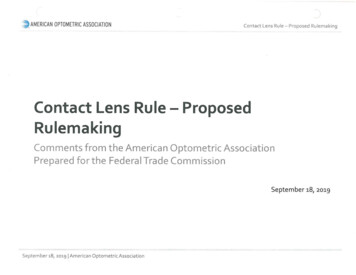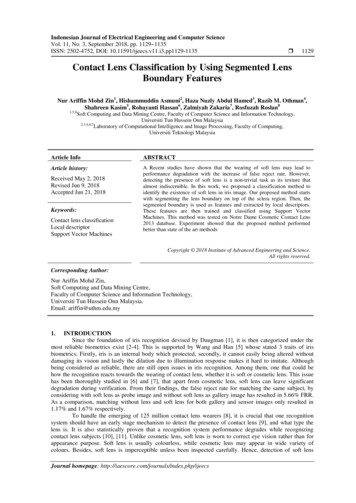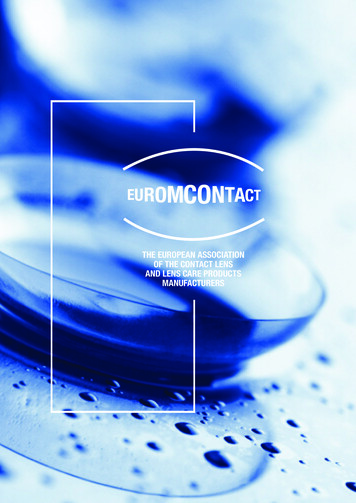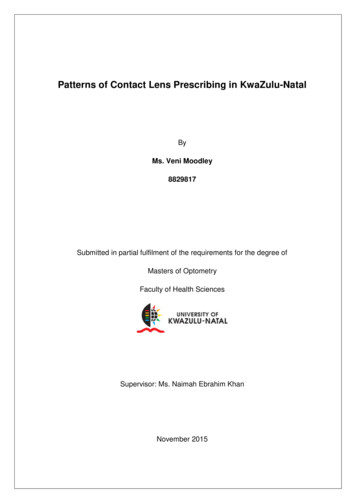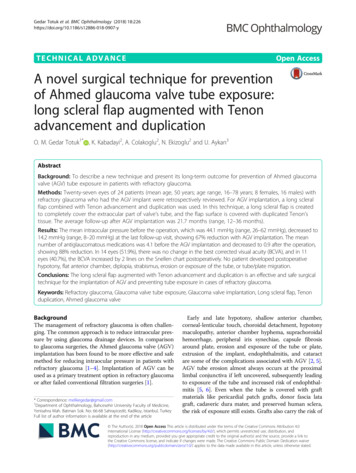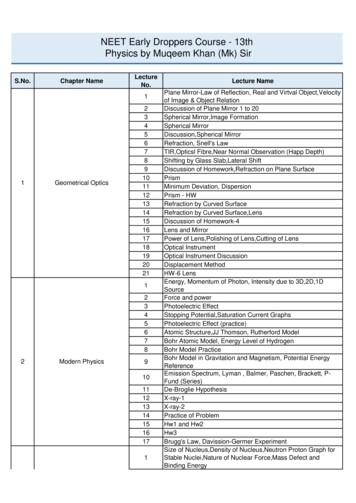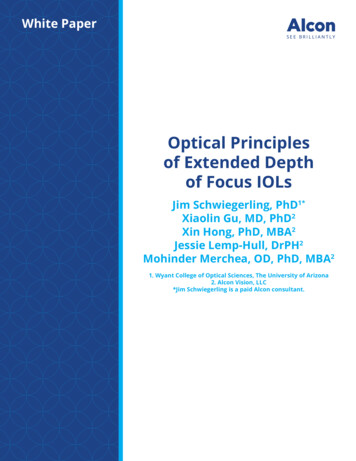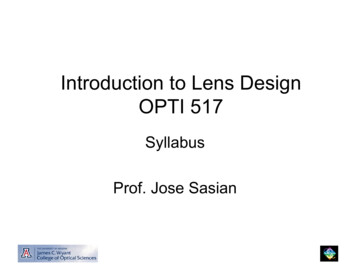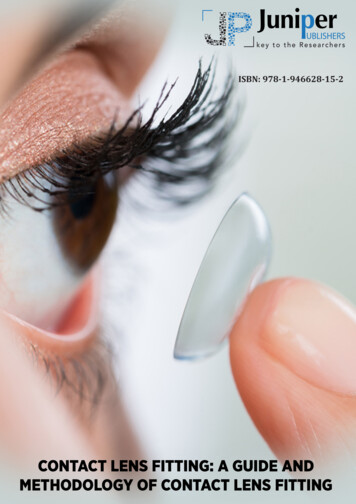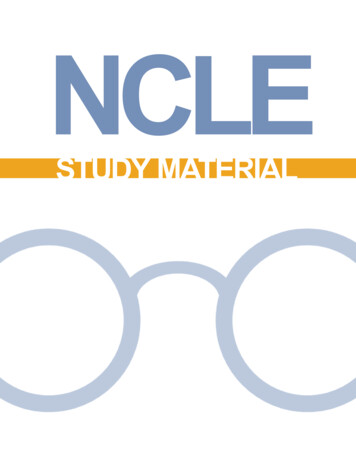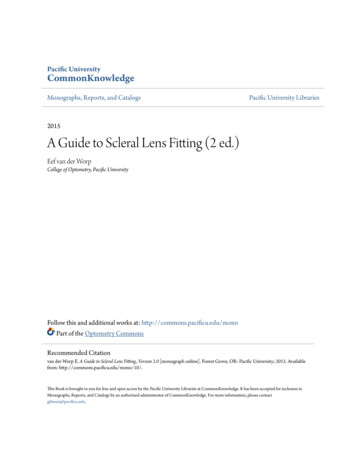
Transcription
Pacific UniversityCommonKnowledgeMonographs, Reports, and CatalogsPacific University Libraries2015A Guide to Scleral Lens Fitting (2 ed.)Eef van der WorpCollege of Optometry, Pacific UniversityFollow this and additional works at: http://commons.pacificu.edu/monoPart of the Optometry CommonsRecommended Citationvan der Worp E. A Guide to Scleral Lens Fitting, Version 2.0 [monograph online]. Forest Grove, OR: Pacific University; 2015. Availablefrom: http://commons.pacificu.edu/mono/10/.This Book is brought to you for free and open access by the Pacific University Libraries at CommonKnowledge. It has been accepted for inclusion inMonographs, Reports, and Catalogs by an authorized administrator of CommonKnowledge. For more information, please contactgilmani@pacificu.edu.
A Guide to Scleral Lens Fitting (2 ed.)DescriptionA new, updated version of the Guide to Scleral Lens Fitting has been launched recently. As the editor of theguide, I had the pleasure of working with an international team of over twenty experts in the field – from allover the world.Personally it feels like the guide only now is finalized, after so many years since its first edition. What started asa ‘simple’ revision of this first edition ended up as a complete makeover of the entire guide. Most probably –almost literally – not a single sentence came out untouched. Although some questions surely remain in thescleral lens arena – the overall consensus and agreement on things is much better than it was back in 2010 atthe time the first edition took shape. It tries to be a state-of-the-art resource – well balanced between thebenefits that we know sclerals can have, and the risks and pitfalls that it involves.As an illustration of the growing-up process: in terms of volume of publications on the topics, the referencelist expanded from 2.5 to 5 pages in total. It seems that the amount of relevant publications since 2010 exceedsthat of the number of publications before that time – a wealth of information – all of which of course wereincorporated in the new guide. Based on the available literature and the priceless clinical input from theinternational board, a new guide is created that seems to be a comprehensive and complete overview ofeverything we know about the topic today in a useful format.NOTE: A corrected version has been posted as of January 5, 2016.Access the first edition of this guide here.This publication is supported by an unrestricted educational grant from Bausch Lomb.DisciplinesOptometryCommentsEef van der Worp, BOptom, PhD FAAO FIACLE FBCLA FSLS – Washington DC (USA)/Amsterdam(the Netherlands)Eef van der Worp is an educator and researcher in the contact lens field. Eef received his optometry degreefrom the Hogeschool van Utrecht in the Netherlands (NL) and his PhD from the University of Maastricht(NL). He is affiliated with Pacific University College of Optometry (USA) and the University of Maastrichtand is a visiting lecturer to many optometry schools. He resides both in Amsterdam (NL) and in WashingtonDC (USA).This book is available at CommonKnowledge: http://commons.pacificu.edu/mono/10
A Guide toScleralLensFittingVersion 2.0Eef van der Worpoptometrist, PhD
A Guide to Scleral Lens FittingContentsPreface . . . . . . . . . . . . . . . . . . . . . . . . . . . . . . . . . . . . . . . . . . . . . . . . . IVI. Introduction . . . . . . . . . . . . . . . . . . . . . . . . . . . . . . . . . . . . . . . . . . . . . 1II. Anatomy and Shape of the Anterior Ocular Surface . . . . . . . . . . . . . 9III. Scleral Lens Design . . . . . . . . . . . . . . . . . . . . . . . . . . . . . . . . . . . . . . 18IV. A Five Step Fitting Approach . . . . . . . . . . . . . . . . . . . . . . . . . . . . . . 27V. Managing Scleral Lens Wear . . . . . . . . . . . . . . . . . . . . . . . . . . . . . . . 44Appendix . . . . . . . . . . . . . . . . . . . . . . . . . . . . . . . . . . . . . . . . . . . . . . 62References . . . . . . . . . . . . . . . . . . . . . . . . . . . . . . . . . . . . . . . . . . . . . 64
Editorial BoardEditorEef van der Worp, BOptom, PhD FAAO FIACLE FBCLA FSLS – Amsterdam (the Netherlands)Eef van der Worp is an educator and researcher in the contact lens field. Eef received his optometry degree from the Hogeschoolvan Utrecht in the Netherlands (NL) and his PhD from the University of Maastricht (NL). He is affiliated with the University ofMaastricht as an associate researcher, is an adjunct Professor at the University of Montreal College of Optometry (CA) and is anadjunct assistant Professor at Pacific University College of Optometry (Oregon, USA).Pacific University College of Optometry, Forest Grove, OR (USA)Pacific University has been active in contact lens research over the last two decades and has been on theforefront of scleral lens education and research. The contact lens team at Pacific University College ofOptometry consists of Patrick Caroline, Beth Kinoshita, Matthew Lampa, Mark André, Randy Kojima, SheilaMorrison, Maria Walker and Jennifer Coyle. Special thanks are due to Tina Graf from the Aalen University inGermany for all of her work and devotion toward the Pacific University Scleral Shape Study.International BoardStephen P. Byrnes, OD FAAO – Londonderry, NH (USA)Steve Byrnes received his optometric training at The New England College of Optometry in Boston, MA (USA) and maintainsa primary care private practice with specialization in contact lenses in Londonderry, NH (USA). He is an academic educationconsultant to many schools and colleges of optometry in the USA for Bausch Lomb. He lectures internationally on rigid gaspermeable contact lens design, fitting and problem-solving.Gregory W. DeNaeyer, OD FAAO FSLS – Columbus, OH (USA)Greg DeNaeyer practices at Arena Eye Surgeons with an emphasis on specialty contact lenses. He was a co-founder and pastpresident of the Scleral Lens Education Society and is a Fellow of the American Academy of Optometry. He is a contributing editorfor Contact Lens Spectrum and a contributor to Review of Cornea and Contact Lenses.Donald F. Ezekiel, AM DipOpt DCLP FACLP FAAO FCLSA – Perth (Australia)Don Ezekiel graduated from the University of Western Australia in Optometry in 1957. He completed his post-graduate studiesin London (UK). While in London, he worked in the practice of contact lens pioneer Dr. Joseph Dallos, who taught him how toresearch and influenced him to make contact lenses for his patients. In 1967, he established a contact lens laboratory in Australia.He is an expert and a pioneer in scleral lens fitting.Greg Gemoules, OD – Coppell, TX (USA)Greg Gemoules received his optometry degree from the Illinois College of Optometry (USA). He moved to Texas and establishedhis practice in Coppell, a growing suburb of Dallas (USA). He has established a large specialty lens practice and has severalpublications in the peer-reviewed literature. He is a pioneer in the use of optical coherence tomography (OCT) and wavefrontguided optics in the fitting of scleral lenses and has lectured at a number of conferences on the topic.Jason Jedlicka, OD FAAO FSLS – Bloomington, IN (USA)Jason Jedlicka is the Chief of the Contact Lens Service and an Associate Professor at the Indiana University School of Optometry.He is a diplomate in the Cornea and Contact Lens Section of the American Academy of Optometry and the immediate pastpresident of the Scleral Lens Education Society.Deborah S. Jacobs, MD – Boston, MA (USA)Deborah Jacobs has been Medical Director at Boston Foundation for Sight since 2006. She earned her MS from Oxford Universityas a Rhodes Scholar and her MD from Harvard Medical School (USA). She completed her ophthalmology residency and fellowshipin Cornea and External Disease at Massachusetts Eye & Ear Infirmary, where she is now a faculty member. She is an assistantclinical professor of Ophthalmology at Harvard Medical School.Lynette Johns, OD FAAOLynette Johns was formerly senior optometrist at the Boston Foundation for Sight. She is an adjunct assistant professor at theNew England College of Optometry (USA) and a fellow of the American Academy of Optometry and the Scleral Lens Society. Sheserves as a clinical and education consultant in specialty lenses of Baush Lomb Boston.iiCraig W. Norman, FCLSA – South Bend, IN (USA)Josh Lotoczky, OD FAAOChad Rosen, OD FAAO – Big Rapids, MI (USA)Craig Norman is the Director of Research at the Michigan College of Optometry (MCO), Ferris State University. A graduate ofthe University of Minnesota’s Physician Assistant of Ophthalmology program and a clinician for the past 30 years, he has beeninvolved in the development and evaluation of numerous products and technologies in the soft, GP and scleral lens category.editorial board
Josh Lotoczky is an Associate Professor at MCO. He earned his doctorate in Optometry from MCO in 2004 and completed a Corneaand Contact Lens residency the following year. He serves as the Chief of the Cornea and Contact Lens Services at the UniversityEye Center and is a Fellow of the American Academy of Optometry.Chad Rosen is the Senior Clinical Fellow at MCO’s Vision Research Institute. He completed a residency in Cornea and ContactLens at Pacific University College of Optometry and then obtained Fellowship of the American Academy of Optometry. He hasbeen involved in a variety of contact lens-related research projects and has lectured throughout the United States on various contactlens topics.Jan Pauwels – Antwerp (Belgium)Jacob H. van Blitterswijk – Arnhem (the Netherlands)Cristian Mertz, BOptom FSLS – Utrecht (the Netherlands)Jan Pauwels, optometrist, is owner of Lens Optical Technology and is working as a contact lens practitioner in three universityhospitals in Belgium, UZA Antwerp, UZG Gent and CHU Liège. He completed his study in optics and optometry in Brussels(Belgium), and spends much of his time in fitting contact lenses on irregular corneas.Jaap van Blitterswijk is a contact lens practitioner, designer, manufacturer and owner of several Dutch contact lens practices. Hecompleted his study in Optics, Optometry and Contact Lenses in Rotterdam, the Netherlands. Jaap spends much of his time ineducating specialty lens fittings.Cristian Mertz graduated from the School of Optometry in Utrecht (the Netherlands). He started working in several Dutch contactlens practices specializing in medical contact lens fitting. He works for Microlens Contact Lens Technology as a clinical andeducational consultant.Kenneth W. Pullum, BSc FCOptom DipCLP FBCLA – Hertford (United Kingdom)Ken Pullum graduated in 1974 at City University (UK). He was awarded the FCOptom in 1975, the DipCLP in 1978, fellowship ofthe BCLA in 2006 and life fellowship of the British College of Optometrists in 2013. He is principal optometrist in the scleral lensservice at Moorfields, Oxford Eye Hospitals, and senior optometrist specializing in contact lens practice at the Queens Hospital,Romford, UK. He is also in private practice and director of Innovative Sclerals Ltd, a manufacturing company of scleral contactlenses, a subject on which he has lectured and written extensively.Perry Rosenthal, MD – Boston, MA (USA)Perry Rosenthal is founder of the Contact Lens Service at Harvard’s Massachusetts Eye and Ear Infirmary, Polymer TechnologyCorporation (the Boston Lens Products) and Boston Foundation for Sight. After being terminated from the Boston Foundationfor Sight, he founded the Boston EyePain Foundation to continue his work in ocular neuropathic pain, including that traditionallyknown as dry eye disease, and is also a part-time Assistant Professor at Harvard Medical School.Christine W. Sindt, OD FAAO FSLS – Iowa City, IA (USA)Christine Sindt is a graduate of The Ohio State University College of Optometry (USA). She completed a disease-based residencyat the Cleveland VA Medical Center (USA). She joined the Faculty of the University of Iowa Department of Ophthalmology andVisual Sciences (USA) in 1995, where she is currently an associate professor of Clinical Ophthalmology and director of the ContactLens Service. She is the co-founder of the Scleral Lens Education Society.Sophie Taylor-West, BSc MCOptomNigel Burnett-Hodd, BSc FCOptom DipCLP – London (United Kingdom)Nigel Burnett-Hodd and Sophie Taylor-West both work at Nigel’s Central London (UK) contact lens specialist practice, whichspecializes in challenging contact lens cases, particularly keratoconus, post-corneal graft and post-LASIK grief patients. SophieTaylor-West has a keen interest in fitting corneo-scleral and hybrid contact lenses and also works part time at her own contact lensspecialist practice in Brighton (UK). Nigel Burnett-Hodd is past-president of both the British Contact Lens Association and theInternational Society of Contact Lens Specialists.Esther-Simone Visser, BOptom MScRients Visser Sr – Nijmegen (the Netherlands)Esther-Simone Visser graduated from the School of Optometry in Utrecht (the Netherlands) in 1995. She obtained her MastersDegree at City University in London (UK) in 2004. She joined The Visser Contact Lens Practice, working at several universityhospitals in the Netherlands, where she continued to specialize in medical contact lens fitting. She subsequently joined the sclerallens fitting and development team of Rients Visser. She has published and presented widely on scleral lenses.Rients Visser followed the study in Optics, Optometry and Contact lenses in Rotterdam (the Netherlands). He specializes in themedical application of contact lenses and is the founder of Visser Contact Lens Practice, which consists of 23 satellite locations,most of them situated in (university) hospitals. The scleral lens team counts eight optometrists and takes care of scleral lenspatients from the Netherlands and abroad. Rients has presented and published widely on scleral lenses and multifocal contactlenses and has developed his own lens designs.editorial boardiii
Preface and AcknowledgementsThis guide is based on an extended literature search on the subject of scleral lens fitting as well as clinical inputfrom experienced scleral lens fitters from around the world. It provides an overview of the latest knowledge andunderstanding of this exciting vision correction method. As an educator, I believe the guide presents an objective,neutral overview that is not biased in any way toward any fitting technique, industry partner or location—asdifferent approaches exist in different parts of the world. Being slightly at a distance as an independent educatorfrom any specific fitting technology or philosophy felt like an advantage in this process.The input from the international editorial board who work with their respective lens designs and principles on adaily basis was paramount for composing this guide: not only did the input from the contributors and reviewersadd tremendously to the content of this guide, their publications and presentations were also invaluable. TheInternational Association of Contact Lens Educators (IACLE) contact lens course modules proved to be anexcellent resource as well—both for understanding the anatomy of the anterior segment as well as for good basicunderstanding of scleral lenses— and they are highly recommended for eye care practitioners in contact lenspractice. See the reference section at the end of the guide for details and a full overview of materials used for thisguide.In addition to the great clinical input from all members of the international board and the contact lens team atPacific University College of Optometry, I would like to thank colleagues at a number of universities for theircollaboration in a variety of scleral lens-related research projects: Langis Michaud at the University of Montreal(Montreal, Canada); Jan Bergmanson, William Miller and Norman Leach of the Texas Eye Research & TechnologyCenter at the University of Houston College of Optometry, USA; Jose Manuel González-Meijome, Daniela LopesFerreira, Miguel, Faria-Ribeiro, Nery Garcia-Porta, Rute Araújo and the team at the Clinical and ExperimentalOptometry Research Laboratory at the University of Minho, Braga in Portugal for a variety of scleral lens-relatedstudies and literature search on the topic. Also thanks to Ron Beerten and Elien Janssen of Procornea in theNetherlands for their valuable input.Joshua Lotoczky, Chad Rosen and Craig Norman of the Michigan College of Optometry provided the scleral lensfit scales, which is a fantastic addition to the 2.0 version of this guide. And special thanks is due to Lisa Starcherfor her work in copy editing and improving the text of the scleral lens guide.Specifically, I would like to thank Rients and Ester-Simone Visser for introducing me to scleral lenses, back whenI was a student, and for their ongoing support and their invaluable input regarding scleral lenses and scleral lenswear. Also, I would like to thank Lynette Johns for being my sparring partner in composing this new version ofthe guide. Her clinical input was invaluable.This guide serves as an introduction to scleral shape, scleral topography and scleral lens design as well as a genericguide to fitting scleral lenses to help the practitioner get more comfortable with the concept of scleral lenses. Itprovides a general overview, supported by the main experienced scleral lens fitters worldwide. Its goal is to givepractitioners a framework to approach and to integrate scleral lens fitting into their practices. Being a generaloverview, it can never cover all of the specific scleral lens designs available and cannot be a fitting guide for all lenstypes available.iv Eef van der WorpprefaceHANS MADERModern scleral lens fitting still is in its infancy, which makes it a modality with great potential. However, fittingscleral lenses is not very black-and-white, and many differences exist among fitters, cultures, manufacturers andcountries. This clinical guide tries to find “common ground” among the mentioned philosophies. For specific lensfitting rules and guidelines, the lens manufacturers and the laboratories’ consultants and specialists should be usedto their fullest potential. In 2006, it was stated in thementioned contact lens course on specialty lens fittingthat, “Although fitted by few contact lens practitioners,Getting comfortablescleral lenses can play a major role in providing anwith scleral lenses optimal visual correction.” This picture has changeddramatically in the meantime, as the modality hasgained a lot of momentum. This 2.0 version of theguide includes an update on the latest developments inthe dynamic field of this vision correction method withscleral lenses, and it provides an overview of managingthe scleral lens patient.
i.Introduction Terminology IndicationsThe concept of optically neutralizing the cornea with anenclosed liquid reservoir over its front surface was firstproposed in 1508 by Leonardo da Vinci. This section brieflycovers the history of scleral lenses, followed by currently usedterminology and the broad spectrum of indications for fittingscleral lenses.It is in the interest ofthe patient that morepractitioners get familiarwith the modality to servepatients with the best opticalcorrection available—whichis often a scleral lens for themore challenging eyes.Large diameter contact lenses that have their resting point beyond the corneal borders are believed to beamong the best vision correction options for irregular corneas; they can postpone or even prevent surgicalintervention as well as decrease the risk of corneal scarring. For true clearance of the cornea, without anymechanical involvement, it seems advised to avoid any contact between the lens and the cornea by bridgingover it. These lenses are technically not “contact lenses,” at least not with the corneal surface—which canbe one of the biggest advantages of this modality.JEAN CLAUDE DERLCOURT ANDJAN PAUWELS (CHU LIEGE, BELGIUM)A number of years back, only a handful of very specialized lens fitters around the world were capable offitting scleral lenses successfully, and only a few manufacturers were making scleral lenses. Now, manycontact lens manufacturers have scleral lens designs in their arsenal. New insights into corneo-scleraljunction and anterior scleral shape as well as improved manufacturingprocesses allow for better design, make lenses more reproducible anddecrease costs. Combined with better lens materials, this has contributedto better ocular health, longer wearing time and ease of lens fit. Manyspecial websites and organizations are devoted to scleral lenses, andconferences and the ophthalmic literature are frequently reportingon scleral lens fitting. It is in the interest of the patient that morepractitioners get familiar with the modality to serve patients with thebest optical correction available—which is often a scleral lens for themore challenging eyes.A scleral lens hand-heldThe first blown scleral shells and ground scleral lenses made of glasswere produced in the late 19th century. In the early 20th century, Carl Zeiss of Jena, Germany offered aset of four lenses that allowed trial fitting of lenses with a known specification. This company was the firstto experiment with plastic lenses and was granted a patent in 1923 for their manufacture from ‘cellon,celluloid or an organic substance with similar mechanical and opticalproperties’. The earliest report on fitting of polymethyl methacrylate(PMMA) scleral lenses appears to have been made by Thier in 1939,and early adopters of plastic materials included Feinbloom, Obrigand Györrfy. Plastic lenses were far less fragile than glass and moreGlass blown Carl Zeiss Jena sclerallens trial set from the early 1920’sIndications for scleral lens fitting have been evolving overthe last few years, emerging from a lens for severely irregularcorneas only to a much broader spectrum of indications.1introduction
easily modified to achieve an optimum fit. In the1930s, Dallos developed the technique for takingeye impressions, the casts of which were usedto produce molded glass lenses that had a wellfitting scleral zone, according to Pearson (2014).Because scleral lenses bridge the cornea,comfort of lens wear is really one of the mostspectacular benefits of these lenses. Some ofour scleral lens patients complained to theirphysicians about why they weren’t referred forscleral lenses earlier, since comfort of lens wearis so good. We also see that many keratoconuspatients with a scleral lens on one eye want tobe fitted with a scleral lens on the other eye tooinstead of a corneal GP lens — again because ofcomfort.Plastic lenses now could be manufactured ona lathe-cut basis and in a much more accuratemanner to mimic the anterior shape of theeye. The use of oxygen permeable lenses,as first described by Ezekiel in 1983, wasanother breakthrough, since this brought majorimprovements in ocular health. The developmentof the smaller, corneal gas permeable lenses andEsther-Simone Visser and Rients Visserlater of soft lenses, in the meantime, temporarilystopped further development of scleral lensfitting, but the scleral lens is now fully back on the agenda as an option for more challenging eyes. Manyscleral lens options are now available to practitioners, including front toric, back toric, bitoric, quadrantspecific and even multifocal lens designs for the correction of presbyopia.TerminologyGREG DENAEYERTerminology for scleral lenses and the definitions for different lenses and lens types have gone throughan evolution in recent years. In the past, this has been diverse, locally determined, oftentimes arbitraryand at times confusing. The Scleral Lens Education Society (SLS) has more recently recommended internationally recognized nomenclature for describing scleral lenses according to size and fit characteristics.The recommendations of the SLS are based on the lens’ resting point on the ocular surface, not on lensdiameter. Simply put, if a rigid gas permeable (GP) lens rests completely on the cornea, it is called a corneallens. A lens that partly rests on the cornea (centrally or peripherally) and partly on the sclera is called acorneo-scleral lens. A lens that rests entirely on the sclera is a scleral lens, no matter how large that lens is.The SLS advises against using diameter classification in scleral lensnomenclature, as this would not suffice in cases of extremely large orsmall eyes, for instance.DON EZEKIELLarge diameter scleral lens holdinga large tear reservoir2Pediatric aphakic scleral lensintroductionThe described nomenclature seems pretty straightforward based onresting zone on the ocular surface. The confusing part to some degreefor eye care practitioners may be that some lenses with, for instance,a 14.5 mm diameter that rests partly on the cornea and partly on thesclera fall within the corneo-scleral lens category, but a lens with theexact same diameter that entirely has its resting zone on the sclera is a(full) scleral lens by definition. It is important to make this distinction,as it is generally agreed upon that in terms of fitting procedure,physiological management of the lens and other recommendations—acorneo-scleral lens is a different entity than a full scleral lens with itslanding zone entirely on the sclera.When there is full landing on the sclera, further distinctions of thescleral lens group, although arbitrary, would include mini-scleral andlarge-scleral lenses. These distinctions emphasize differences in centralcorneal clearance and other fitting characteristics. As an example,
a lens that is 6 mm larger than the horizontal visible iris diameter (e.g., has up to 3 mm of bearing on thesclera on each side of the cornea) is classified as a mini-scleral lens. A lens that is more than 6 mm largerthan the visible iris diameter is clas-sified as a large-scleral lens. For an eye with an average corneal diameterof 12 mm, an 18 mm lens that lands exclusively on the sclera would be a mini-scleral lens, while a lenslarger than 18 mm for the same eye would be a large-scleral lens. In this guide, the term scleral lens is usedto describe the broad range of all large diameter lens modalities, but if a specific lens type is referred to, thenthat terminology (e.g., corneo-scleral, full-scleral, mini-scleral and large-scleral) will be used.The biggest difference apart from landing area and location among the smaller and the larger diameterscleral lenses is the amount of clearance that can be created beneath the central lens. In small diameterlenses, the tear reservoir capacity is typically small, while in the large diameter scleral lenses, the tearreservoir capacity is almost unlimited. But all types of (mini-) scleral contact lens designs have the abilityto promote good apical clearance to some degree compared to corneal contact lenses. This can reducemechanical stress to the cornea, which is considered a major advantage of any type of scleral lens.TerminologyBearingCornealLens rests entirely onthe corneaCorneoScleralLens rests partly on thecornea,partly on the sclera(Full)ScleralMini-scleralLens is up to 6mm largerthan HVIDLarge-scleralLens is more than 6mmlarger than HVIDLens rests entirely onthe scleraThe Scleral Lens Education Society (SLS) introduced aninternationally recognized nomenclature for describing sclerallenses based on the resting zone area of the lens on the ocularsurface, not on lens diameter.SOPHIE TAYLOR-WESTSubdivisionCorneo-scleral lenses on post RKcorneasIndicationsIndications for scleral lens fitting have been evolving over the last few years, emerging from a lens forseverely irregular corneas only to a much broader spectrum of indications, which can be broadly categorizedas (van der Worp 2014, Schornack 2015):1. Vision ImprovementCorrecting the irregular cornea to restore vision is the main indication for fitting scleral lenses. Thelargest segment within this category is corneal ectasia, which can be subdivided into two groups. Firstis the primary corneal ectasia group (McMahon 2013), which includes conditions such as keratoconus,keratoglobus and pellucid marginal degeneration. The secondary ectasia group consists of post-refractivesurgery, including post-laser assisted in-situ keratomileusis (LASIK), post-laser assisted epithelialintroduction3
Keep in mind that corneosclerals are easier for parttime users compared tocorneal GPs due to little orno adaptation. The largerdiameter means less lidinteraction—and very littleadaptation is necessary.keratoplasty (LASEK), post-photorefractive keratectomy (PRK) andpost-radial keratotomy (RK), and corneal trauma. A recent study byLo et al (2014) looked at scleral lens use after unsuccessful refractivesurgery results. The follow-up period was 14.4 months; all eyesachieved significant improvement in best corrected visual acuity,and none of the patients in the study discontinued scleral lens wear.This poses the lenses as a serious consideration for these corneas, theauthors concluded.The primary ectasia group also consists of corneas that have beentreated surgically to manage the ectasia in various ways—such asintrastromal ring implants and, more recently, corneal crosslinking.Visser et al (2014) studied the latter group and concluded that sclerallenses are well accepted in these patients and can be an excellent indication to restore vision. Cornealtransplants for primary ectasia, especially the penetrating keratoplasty technique, often require a contactlens post-surgery to fully restore vision. A scleral lens may be indicated in many of these cases, especially asit can help to preserve these fragile corneas and prevent mechanical strain. This may require extra attentionin terms of creating adequate clearance (see ch
Greg DeNaeyer practices at Arena Eye Surgeons with an emphasis on specialty contact lenses. He was a co-founder and past president of the Scleral Lens Education Society and is a Fellow of the American Academy of Optometry. He is a contributing editor for Contact Lens Spectrum and a contributor to Review of Cornea and Contact Lenses.
